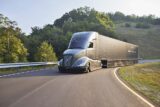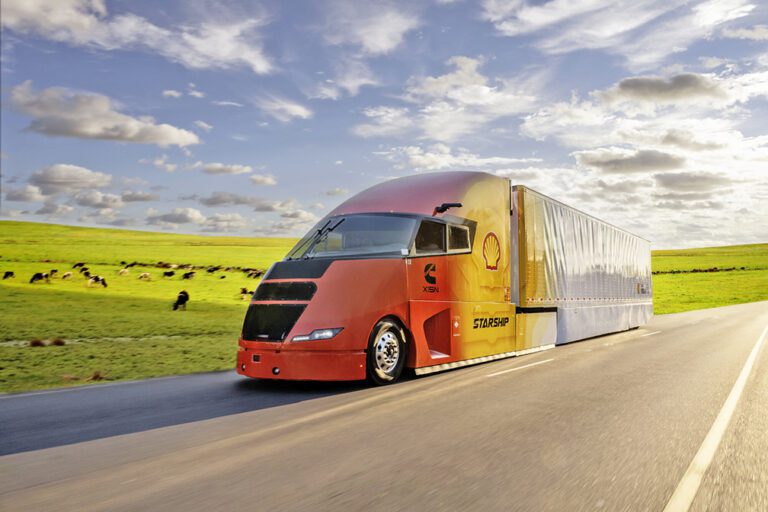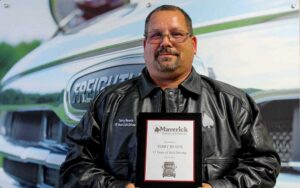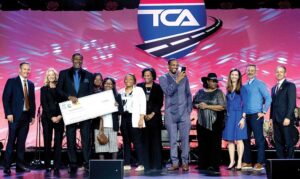HOUSTON — Two companies with special Class 8 tractor projects dealing with emissions and aerodynamics have issued reports on their progress.
The Shell Starship 3.0 has completed a U.S. West Coast demonstration run once again, and company officials say the rig showcases “the art of the possible for efficiency and carbon reduction in commercial road transport.”
This third generation Starship truck, equipped with a Cummins X15N natural gas engine and powered by renewable natural gas (RNG), ran a fully loaded trailer on an 840-mile loop throughout California collecting critical performance data, a news release stated.
Over at Volvo Trucks North America (VTNA), officials have unveiled the company’s SuperTruck 2, with the debut on the VTNA YouTube channel.
The SuperTruck 2 program, a public-private partnership with the U.S. Department of Energy (DOE), tasked manufacturers with achieving a 100% freight efficiency improvement over their submitted 2009 baseline, a news release stated.
“Despite the daunting supply chain challenges facing the advanced engineering team throughout the COVID-19 pandemic, Volvo Trucks not only achieved the DOE objective but exceeded expectations, achieving 134% increase in freight efficiency,” according to the news release.
Volvo Trucks’ SuperTruck 2 will make its first public appearance in the Volvo Trucks booth ( number 4097) at the American Trucking Associations’ 2023 Management Conference & Exhibition, taking place Oct. 14-17 in Austin, Texas, offering a glimpse at styling and engineering cues for future generations of trucks.
Meanwhile, Shell’s Starship 3.0, loaded with Shell Rotella engine oil, measured sustainable freight ton efficiency using ton-miles of goods transported per kilogram of CO2 emitted (FTE CO2e). These results were third-party monitored and verified by The North American Council for Freight Efficiency (NACFE), as was done with the first two versions of the Starship demonstrations.
Shell Starship 3.0 completed the demonstration run while operating near the maximum permissible gross vehicle weight of 80,000 pounds for a Class 8 truck. Shell Starship 3.0 achieved improvements over the U.S. average for diesel class 8 trucks of 2.54 times better freight ton efficiency (FTE) assessed on a ton-miles per gallon basis and 3.23 times better FTE assessed on a ton-miles per kg of CO2e emitted basis.
The Cummins X15N natural gas engine, powered by RNG, emits less CO2 than a diesel engine and further confirms to fleets the potential for different engine and fuel options to reduce CO2 emissions. RNG is a natural gas transportation fuel that can be derived from organic waste and is interchangeable with compressed natural gas and liquified natural gas in transport vehicles.
“Shell Starship 3.0 demonstrates the power of innovation by incorporating a new natural gas engine complimented by today’s available technologies to help reduce emissions in the road transport industry,” said Dr. Selda Gunsel, president of Shell Global Solutions and vice president of fuels and lubricants technology. “Industry collaboration is critical in helping fleets achieve their sustainability goals.”
Similar to its predecessors, the truck also included components and features that promote lightweighting, low aerodynamic drag and low rolling resistance tires, according to the news release.
Shell Starship 3.0 operated using a low-viscosity Shell Rotella natural gas engine oil and Shell Spirax transmission and axle oils. Low-viscosity lubricants require less energy to move throughout the engine while still providing the protection, efficiency, and performance needed in harsh operating environments.
“Each Starship generation shows our current and future customers that we are leading the effort to empower fleets with real-world data that will help guide their decisions to help reduce emissions,” said Tom Mueller, general manager of Shell Commercial Road Transport Lubricants. “Shell Starship is a proving ground of how working together across the industry can lead the way to more sustainable solutions.”

Back at Volvo, VTNA President Peter Voorhoeve said that partnering with the DOE for the SuperTruck program “provides an exciting opportunity to push the technology envelope to see what’s technically possible for heavy-duty transportation and which solutions can be scaled into production, but equally important, which solutions don’t work for scaled production.
Voorhoeve added that the company is “extremely proud of the accomplishments of our advanced engineering team who worked on SuperTruck 2. A program of this magnitude pushes the limits in every possible area — creativity, problem solving, feasibility and innovation, to which we feel we did successfully. Some of the technologies on SuperTruck 2 will most certainly shape the future of trucking and change everything we once thought possible.”
DOE’s SuperTruck 2 program promotes research and development to improve the freight efficiency of heavy-duty Class 8 long-haul tractor-trailer trucks, the news release stated.
The program aims to accelerate the development of cost-effective advanced efficiency technologies not currently available in the market. For SuperTruck 2, all participating OEMs were given the goal of demonstrating more than 100% improvement in vehicle freight efficiency (ton-mile-per-gallon). Volvo Trucks met that goal and exceeded its internal stretch goal of 120% freight efficiency improvement relative to the 2009 baseline, achieving 134% under real world demonstrator validation.
For Volvo Trucks’ SuperTruck 2 program, advanced aerodynamics are the key to optimizing fuel efficiency.
Starting with a wedge-shaped cab from front to back, including a raked and wraparound windshield, a front end designed around a downsized cooling package, a fully aerodynamic trailer with gap fairings, skirts and boat tail, as well as an adjustable ride height. Volvo Trucks also replaced the traditional hood and cab mounted mirrors with a streamlined camera monitoring system to reduce the drag by more than 4%.
The entire tractor-trailer combination was designed to smoothly displace air with minimal resistance, resulting in 50% lower drag than Volvo Trucks’ 2009 baseline.
This represents a roughly 20% improvement in aerodynamic drag over Volvo Trucks’ SuperTruck, VTNA officials reported.
Around two-thirds of the drag reduction in SuperTruck 1 over the 2009 baseline came from trailer aerodynamic treatments — optimizing the skirt and boat tail.
Since SuperTruck 2 also boasts optimized trailer skirt and boat tail, most of its aerodynamic gains over SuperTruck 1 can be attributed to a brand-new cab design, including a radically different windshield, while SuperTruck 1 was a slightly modified version of a VNL 670 cab. SuperTruck 2 demonstrated the potential for significant aerodynamic gains from changing the body-in-white.
In addition to the aerodynamics advancements, engineers implemented several weight reduction strategies to achieve a significantly reduced curb weight of 27,000 pounds for the combined truck and the trailer. Volvo Trucks chose to utilize a 4-by-2 configuration, which is not common in the U.S. but is frequently utilized in Europe using fewer axles for the same payload.
The shorter cab design is lightweight and paired with an aluminum chassis that uses a lightweight optimized drive axle system with a single composite driveshaft.
Volvo Trucks worked with the project partner trailer manufacturer to incorporate a custom, lightweight aerodynamic trailer with an optimized aerodynamic shape of the full truck and trailer to appear as one seamless unit. Volvo Trucks also worked with the project partner tire manufacturer to include lightweight, smaller 19.5-inch advanced low-friction tires on both the SuperTruck 2 and its custom trailer.
With a focus on the driving environment, the Volvo Trucks SuperTruck 2 features a 48-volt micro hybrid system that acts as a generator with an integrated starter. This provides power for driver comfort features, including an all-electric HVAC system that allows the driver to avoid idling during rest breaks and still have power for amenities.
“The project team deliberately focused on driving in real world conditions for testing. Data wasn’t just gathered in a lab or on flat, empty roads with optimal conditions and a light load. Instead, our SuperTruck 2 was tested in real-world scenarios on roads with traffic and elevation changes with a GCVW of 65,000 lbs.” Voorhoeve said. “This is the most aerodynamic and efficient truck Volvo has built to date, and we achieved a freight efficiency that demonstrates the potential for technology innovations to be developed commercially. Our engineers have already begun implementing some of the learnings from SuperTruck 2 into our future truck models. The future of trucks is just around the corner.”
Born in Pine Bluff, Arkansas, and raised in East Texas, John Worthen returned to his home state to attend college in 1998 and decided to make his life in The Natural State. Worthen is a 20-year veteran of the journalism industry and has covered just about every topic there is. He has a passion for writing and telling stories. He has worked as a beat reporter and bureau chief for a statewide newspaper and as managing editor of a regional newspaper in Arkansas. Additionally, Worthen has been a prolific freelance journalist for two decades, and has been published in several travel magazines and on travel websites.















